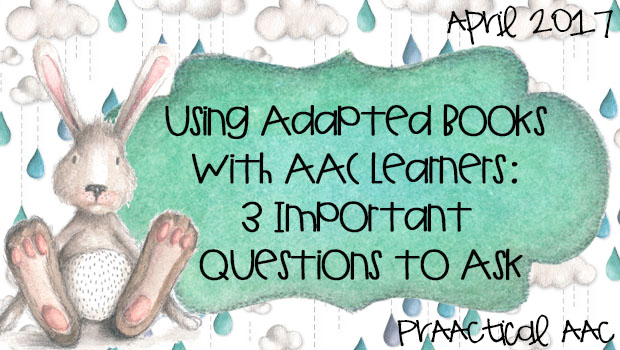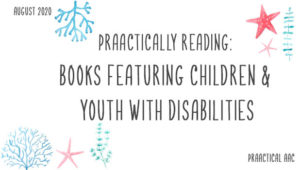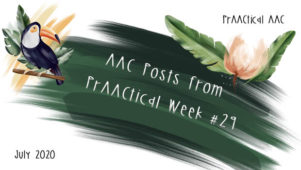Using Adapted Books with AAC Learners: 3 Important Questions to Ask

We’re seeing a big increase in the number of families and professionals who are prioritizing literacy instruction for people with AAC needs, and that makes us VERY happy. In some cases, families, teachers, and therapists are using adapted books in their shared reading activities and making them available for self-selected reading, too.
There are lots of ways to adapt books, though, and not every adaptation is appropriate for an individual who uses or is learning AAC. In this post, we talk about some of the things to consider when making decisions about adapted books.
The term ‘adapted book’ refers to a book that was altered in some fashion to make it more accessible to people with disabilities. There are different ways of modifying books including:
- Simplifying or revising the text,
- Adding AAC symbols to the text,
- Changing the format (e.g., cutting it apart, binding it at the top, and reassembling, make an electronic copy of the book)
- Using page fluffers, tabs, or other methods of separating the pages to make them easier to turn, and,
- Adding interactive elements or removable pieces.
Many AAC interventionists use them and for good reasons. There are quite a few places to get the files to print and assemble adapted books, some of them for free and some for sale. The online marketplace Teachers Pay Teachers has dozens of adapted books for sale, and some free ones as well. Some school districts, like this one by the Alaska Special Education Service Agency, offer adapted books in their library. Other school districts and some disability agencies house a selection of adapted book files that anyone can download for free. There are even more free ones available on AAC or related websites like LessonPix and Boardmaker Online.
As tempting as it is to get started, it may be helpful to slow down and evaluate the situation before you invest your time and/or money. There is some cost to making adapted books, even when the site offers the files for free. To create the actual books, costs us some time, color ink, laminating pouches, etc. Here are some things to consider before getting started.
- What purpose does the adaptation serve?
- Think about the access to language in a more global sense. After the book activity is done, how will he/she access those words?
- Did the reading activity help them get more fluent in overall language and communication, or was their success limited to that single activity?
- Make sure that the ways in which the book is adapted fits the needs of the learner. Tools like the Protocol for Accommodations in Reading (PAR) can give helpful insights.
- Thinking of using books that have AAC symbols added to the text of the story? This post by AAC and literacy expert Jane Farrall explains some of the issues that can help you decide if symbol-supported text is best for your learner.
- Books that have adapted pieces can be great for building engagement but be careful about using them for expressive communication. Sure, the student may be able to take off the correct picture or symbol in response to your question, but go deeper and examine whether that response has that really contributed to their communicative growth.
- Will my client/student benefit from that kind of adaptation?
- As we all know, AAC learners have diverse needs. An adapted book that works beautifully for one learner is not helpful for another. Consider these two examples.
- Carli’s SLP purchased a wonderful set of adapted book files with removable pieces that are used to complete sentences or answer questions on each page (e.g., “Bear put on his ____”; “What color is the biggest fish?”). She painstakingly printed, laminated, added velcro, and assembled each book. It worked well to engage Carli during shared reading, but the SLP modeled the response on Carli’s AAC app and helped Carli use that to build her own sentences about each page.
- The SLP was caught off-guard, however, when she used the same adapted books with Braydon, who had a low tech SGD with very limited vocabulary. Because his static display SGD had so few words (32 per level), Braydon’s only option was to use the removable pieces in the book to respond. While the activity went smoothly (Braydon loved it!), the SLP questioned whether it had really benefited her young student. After all, once the activity was finished, he was left with no way to access the words that he used successfully using the pictures and symbols in the story.
- Same book, different learners. Considering the kind of adaptation each student needs can help us make decisions that maximize growth and achievement.
- Is it a good book?
- We are often enticed by the adaptation, but if the book itself isn’t good, then it may not be worth the investment. What makes a good book? Well, it should be interesting, for starters. There’s not much that you can achieve therapeutically or educationally if the book is boring, even if the text makes it appropriate for your student’s language goals. When we use books that lack interesting characters and events, it doesn’t do much to help build a love of reading. We may have won the battle, but we’re probably losing the war. If we choose adapted books that are built on the learner’s interests or have engaging story lines, we are more likely to help our students want to engage in future opportunities for shared book reading.
Do you use adapted books in your work with AAC learners? We’d love to hear about those experiences.
Filed under: Featured Posts, PrAACtical Thinking
Tagged With: adapted books, Books, literacy, reading
This post was written by Carole Zangari





5 Comments
I couldn’t get the Jane Farrall link to open.
Sorry about that, Janice! Here is the direct link: http://www.janefarrall.com/symbol-supported-text-does-it-really-help/ . Hope that helps!
Hi Carol 😊 Love this post! Jane Farrall’s hyperlink to symbol supported text is no longer valid; can you please restore it? Thank you, Carol
Alicia, it is working now but here is the direct link just in case: http://www.janefarrall.com/symbol-supported-text-does-it-really-help/ .
You are so right i spent so much time building books for my son with removable pieces and all this fancy stuff to only find he didnt care about them …so all the effort was for nothing. I found the biggest challenge was to find adapted books with the specific aac symbols my son is using on his board, or good books that were appropriate for him that would teach him something!!!
The whole thing is really challenging thank u so much for this article it really helps !!!